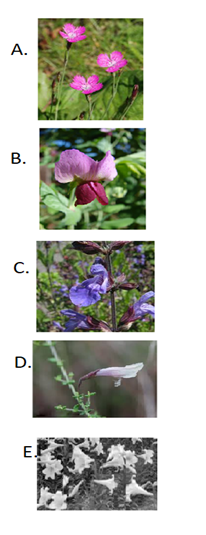
Identify corolla as per sequence given below

A) A-Caryophyllaceous, B-Papilionaceous, C-Bilabiate, D-Tubular, E-Bell shaped
B) A-Bilabiate, B- Papilionaceous, C-Caryophyllaceous, D-Bell shaped, E- Tubular
C) A- Papilionaceous, B- Bilabiate, C- Tubular, D-Bell shaped, E- Caryophyllaceous
D) A- Caryophyllaceous, B- Bilabiate, C- Papilionaceous, D- Tubular, E- Bell-shaped

Answer
505.8k+ views
Hint: Aestivation refers to the way sepals or petals in a floral bud are arranged in relation to the other members of the same whorl. Valvate, twisted, imbricate, and vexillary aestivation are the most common forms.
Complete answer:
The term "corolla" refers to a flower's entire set of petals. Petals are normally followed by a group of modified leaves known as sepals, which form the calyx and lie just beneath the corolla. The perianth is made up of the calyx and the corolla.
The identity of the corolla as per the sequence given below-
A) Caryophyllaceous is a term that refers to or describes pink-flowered plants (Caryophyllaceae) Five-petaled flowers with long claws in a tubular calyx
B) The papilionaceous corolla is a type of aestivation found in the Papilionaceae family that has five petals, with the largest petal, the norm or vexillum, overlapping the two lateral petals, wings, which overlap two smallest anterior petals, keels.
C) Bilabiate - The corolla is a zygomorphic, sympathetic corolla with the limb split into two lips, making it a bilabiate. The corollas of Lamiaceae (the mint family) are typically bilabiate.
D) Tubular- When the petals of a flower join to form a short cylindrical tube-like structure with small lobes, as in the disc florets of marigolds and Helianthus, the corolla is said to be tubular.
E) Bell-shaped- is also called the campanulate corolla. A long tube more or less ventricose at the base, ending with little recurved lobes, shaped like a bell or campana, characterizes the calyx and corolla of certain flowers; resembling a flower of the genus Campanula in form.
As explained above, the correct answer is A. a-Caryophyllaceous, b-Papilionaceous, c-Bilabiate, d-Tubular, e-Bell shaped.
Thus the correct answer is option ‘A’.
Note: The corolla's primary role is to aid the plant's reproductive process. The corolla's petals are intended to aid pollination and thus increase the flower's chances of successful reproduction. Carolla also makes the flower look attractive so that the insects are attracted.
Complete answer:
The term "corolla" refers to a flower's entire set of petals. Petals are normally followed by a group of modified leaves known as sepals, which form the calyx and lie just beneath the corolla. The perianth is made up of the calyx and the corolla.
The identity of the corolla as per the sequence given below-
A) Caryophyllaceous is a term that refers to or describes pink-flowered plants (Caryophyllaceae) Five-petaled flowers with long claws in a tubular calyx
B) The papilionaceous corolla is a type of aestivation found in the Papilionaceae family that has five petals, with the largest petal, the norm or vexillum, overlapping the two lateral petals, wings, which overlap two smallest anterior petals, keels.
C) Bilabiate - The corolla is a zygomorphic, sympathetic corolla with the limb split into two lips, making it a bilabiate. The corollas of Lamiaceae (the mint family) are typically bilabiate.
D) Tubular- When the petals of a flower join to form a short cylindrical tube-like structure with small lobes, as in the disc florets of marigolds and Helianthus, the corolla is said to be tubular.
E) Bell-shaped- is also called the campanulate corolla. A long tube more or less ventricose at the base, ending with little recurved lobes, shaped like a bell or campana, characterizes the calyx and corolla of certain flowers; resembling a flower of the genus Campanula in form.
As explained above, the correct answer is A. a-Caryophyllaceous, b-Papilionaceous, c-Bilabiate, d-Tubular, e-Bell shaped.
Thus the correct answer is option ‘A’.
Note: The corolla's primary role is to aid the plant's reproductive process. The corolla's petals are intended to aid pollination and thus increase the flower's chances of successful reproduction. Carolla also makes the flower look attractive so that the insects are attracted.
Recently Updated Pages
Master Class 12 Economics: Engaging Questions & Answers for Success

Master Class 12 Maths: Engaging Questions & Answers for Success

Master Class 12 Biology: Engaging Questions & Answers for Success

Master Class 12 Physics: Engaging Questions & Answers for Success

Master Class 8 Maths: Engaging Questions & Answers for Success

Class 8 Question and Answer - Your Ultimate Solutions Guide

Trending doubts
Which animal has three hearts class 11 biology CBSE

1 Quintal is equal to a 110 kg b 10 kg c 100kg d 1000 class 11 physics CBSE

Explain zero factorial class 11 maths CBSE

Mention the basic forces in nature class 11 physics CBSE

What is centripetal acceleration Derive the expression class 11 physics CBSE

Bond order ofO2 O2+ O2 and O22 is in order A O2 langle class 11 chemistry CBSE




